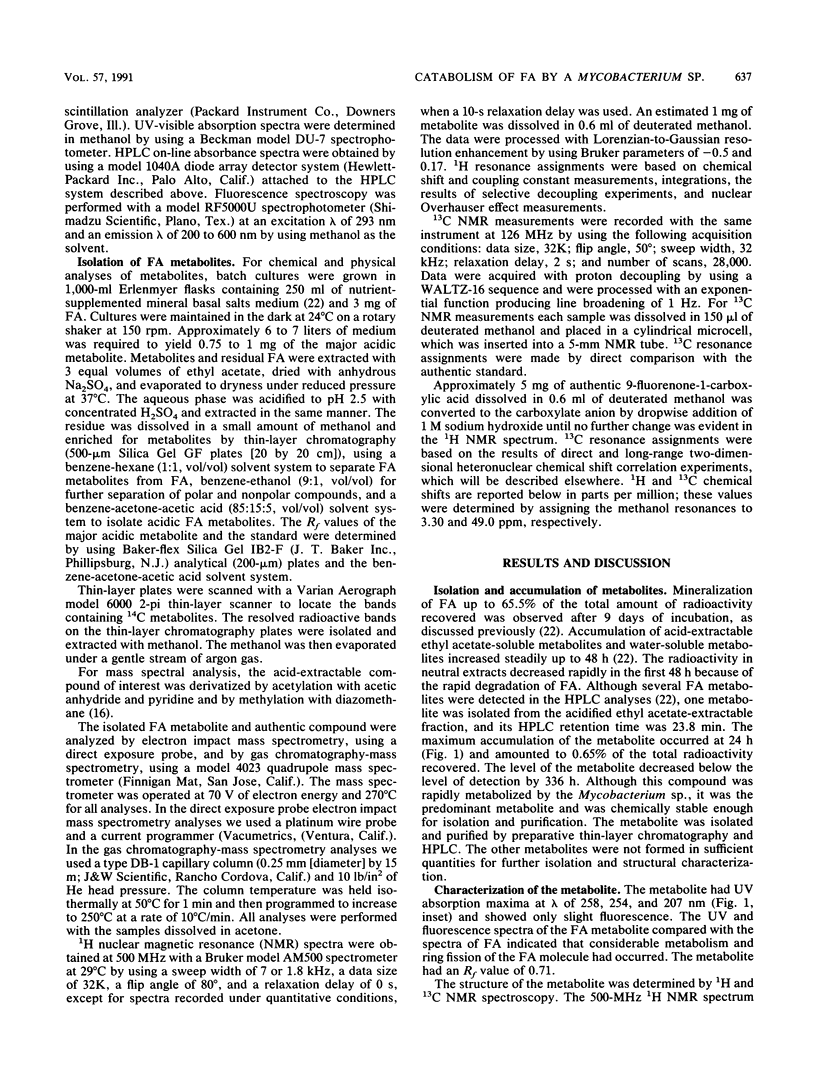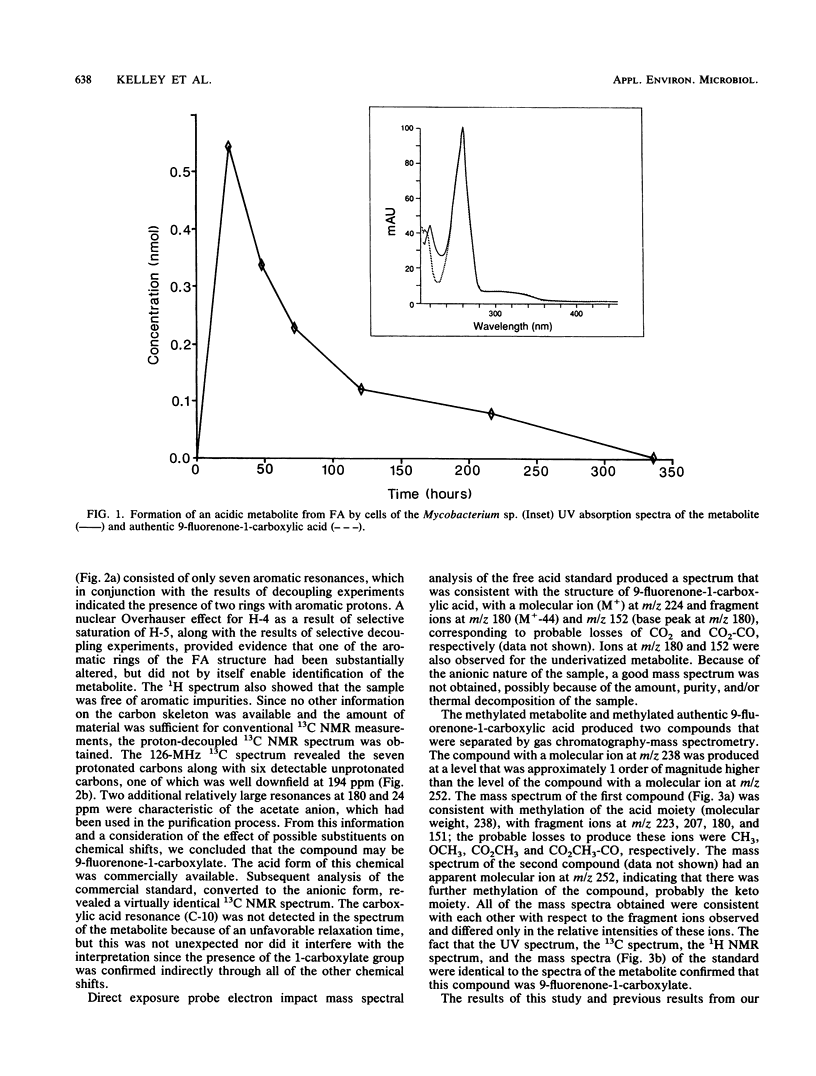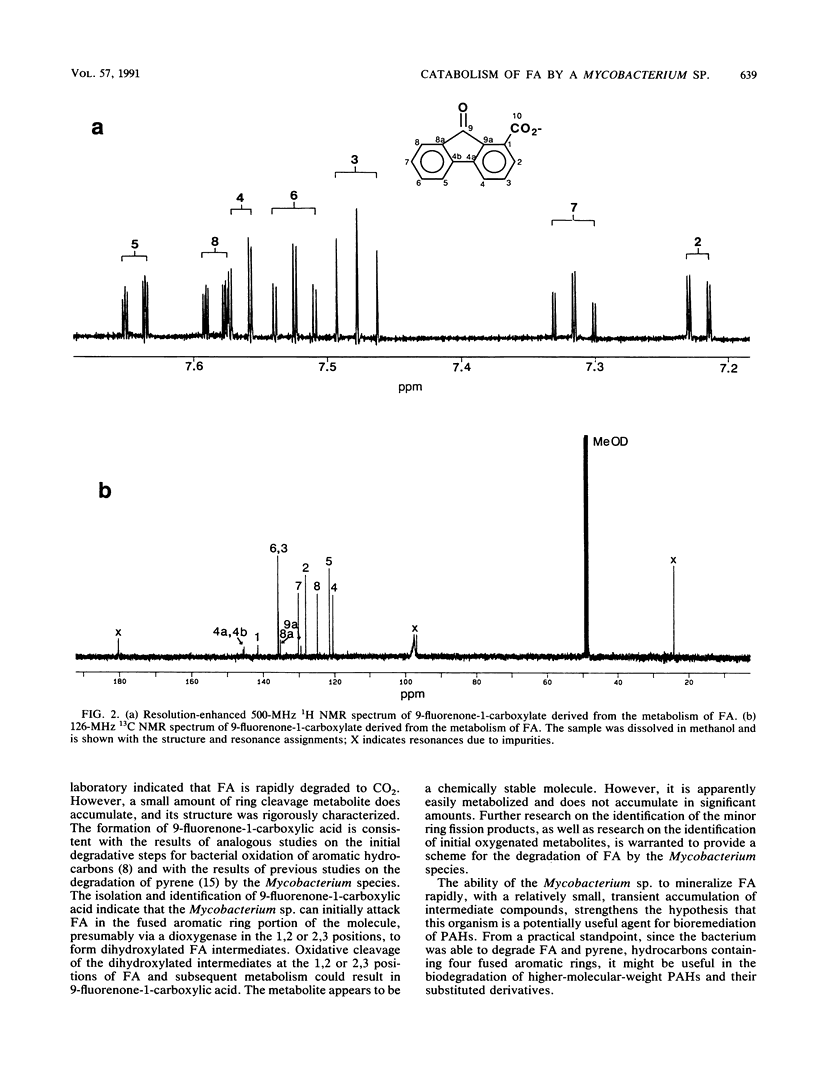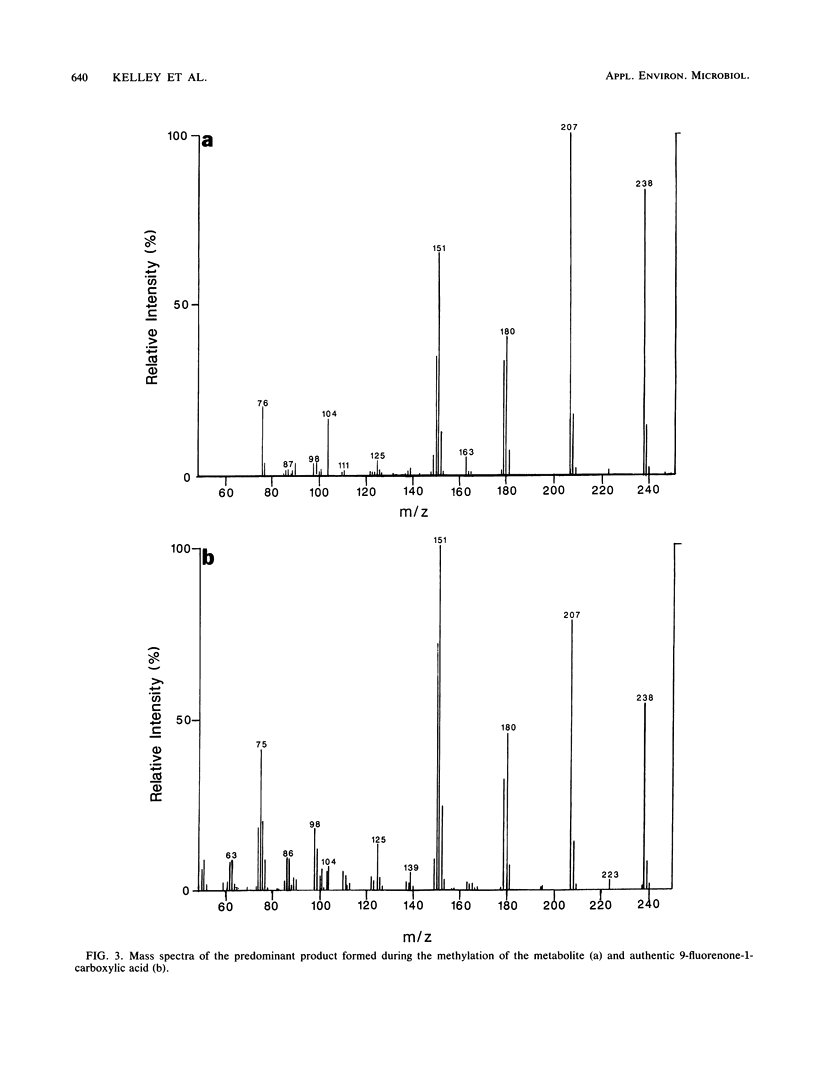Abstract
A Mycobacterium sp. previously isolated from oil-contaminated estuarine sediments was capable of extensively mineralizing the high-molecular-weight polycyclic aromatic hydrocarbon fluoranthene. A carboxylic acid metabolite accumulated and was isolated by thin-layer and high-pressure liquid chromatographic analyses of ethyl acetate extracts from acidified culture media. The metabolite reached a maximum concentration of approximately 0.65% after 24 h of incubation. On the basis of comparisons with authentic compound in which we used UV and fluorescence spectrophotometry and Rf values, as well as mass spectral and proton and carbon nuclear magnetic resonance spectral analyses, the metabolite was identified as 9-fluorenone-1-carboxylic acid. This is the first report in a microbial system of a fluoranthene metabolite in which significant degradation of one of the aromatic rings has occurred.
Full text
PDF





Selected References
These references are in PubMed. This may not be the complete list of references from this article.
- Babson J. R., Russo-Rodriguez S. E., Rastetter W. H., Wogan G. N. In vitro DNA-binding of microsomally-activated fluoranthene: evidence that the major product is a fluoranthene N2-deoxyguanosine adduct. Carcinogenesis. 1986 Jun;7(6):859–865. doi: 10.1093/carcin/7.6.859. [DOI] [PubMed] [Google Scholar]
- Babson J. R., Russo-Rodriguez S. E., Wattley R. V., Bergstein P. L., Rastetter W. H., Liber H. L., Andon B. M., Thilly W. G., Wogan G. N. Microsomal activation of fluoranthene to mutagenic metabolites. Toxicol Appl Pharmacol. 1986 Sep 30;85(3):355–366. doi: 10.1016/0041-008x(86)90343-1. [DOI] [PubMed] [Google Scholar]
- Barnsley E. A. The bacterial degradation of fluoranthene and benzo[alpyrene. Can J Microbiol. 1975 Jul;21(7):1004–1008. doi: 10.1139/m75-148. [DOI] [PubMed] [Google Scholar]
- Bos R. P., Prinsen W. J., van Rooy J. G., Jongeneelen F. J., Theuws J. L., Henderson P. T. Fluoranthene, a volatile mutagenic compound, present in creosote and coal tar. Mutat Res. 1987 Mar;187(3):119–125. doi: 10.1016/0165-1218(87)90078-4. [DOI] [PubMed] [Google Scholar]
- Busby W. F., Jr, Goldman M. E., Newberne P. M., Wogan G. N. Tumorigenicity of fluoranthene in a newborn mouse lung adenoma bioassay. Carcinogenesis. 1984 Oct;5(10):1311–1316. doi: 10.1093/carcin/5.10.1311. [DOI] [PubMed] [Google Scholar]
- Foght J. M., Westlake D. W. Degradation of polycyclic aromatic hydrocarbons and aromatic heterocycles by a Pseudomonas species. Can J Microbiol. 1988 Oct;34(10):1135–1141. doi: 10.1139/m88-200. [DOI] [PubMed] [Google Scholar]
- Groenewegen D., Stolp H. Mikrobieller Abbau von polyzyklischen aromatischen Kohlenwasserstoffen. Zentralbl Bakteriol Orig B. 1976 Jul;162(1-2):225–232. [PubMed] [Google Scholar]
- Heitkamp M. A., Cerniglia C. E. Mineralization of polycyclic aromatic hydrocarbons by a bacterium isolated from sediment below an oil field. Appl Environ Microbiol. 1988 Jun;54(6):1612–1614. doi: 10.1128/aem.54.6.1612-1614.1988. [DOI] [PMC free article] [PubMed] [Google Scholar]
- Heitkamp M. A., Cerniglia C. E. Polycyclic aromatic hydrocarbon degradation by a Mycobacterium sp. in microcosms containing sediment and water from a pristine ecosystem. Appl Environ Microbiol. 1989 Aug;55(8):1968–1973. doi: 10.1128/aem.55.8.1968-1973.1989. [DOI] [PMC free article] [PubMed] [Google Scholar]
- Heitkamp M. A., Franklin W., Cerniglia C. E. Microbial metabolism of polycyclic aromatic hydrocarbons: isolation and characterization of a pyrene-degrading bacterium. Appl Environ Microbiol. 1988 Oct;54(10):2549–2555. doi: 10.1128/aem.54.10.2549-2555.1988. [DOI] [PMC free article] [PubMed] [Google Scholar]
- Heitkamp M. A., Freeman J. P., Miller D. W., Cerniglia C. E. Pyrene degradation by a Mycobacterium sp.: identification of ring oxidation and ring fission products. Appl Environ Microbiol. 1988 Oct;54(10):2556–2565. doi: 10.1128/aem.54.10.2556-2565.1988. [DOI] [PMC free article] [PubMed] [Google Scholar]
- Holder C. L., Korfmacher W. A., Slikker W., Jr, Thompson H. C., Jr, Gosnell A. B. Mass spectral characterization of doxylamine and its rhesus monkey urinary metabolites. Biomed Mass Spectrom. 1985 Apr;12(4):151–158. doi: 10.1002/bms.1200120403. [DOI] [PubMed] [Google Scholar]
- Kaden D. A., Hites R. A., Thilly W. G. Mutagenicity of soot and associated polycyclic aromatic hydrocarbons to Salmonella typhimurium. Cancer Res. 1979 Oct;39(10):4152–4159. [PubMed] [Google Scholar]
- LaVoie E. J., Hecht S. S., Bedenko V., Hoffmann D. Identification of the mutagenic metabolites of fluoranthene, 2-methylfluoranthene, and 3-methylfluoranthene. Carcinogenesis. 1982;3(8):841–846. doi: 10.1093/carcin/3.8.841. [DOI] [PubMed] [Google Scholar]
- Mueller J. G., Chapman P. J., Blattmann B. O., Pritchard P. H. Isolation and characterization of a fluoranthene-utilizing strain of Pseudomonas paucimobilis. Appl Environ Microbiol. 1990 Apr;56(4):1079–1086. doi: 10.1128/aem.56.4.1079-1086.1990. [DOI] [PMC free article] [PubMed] [Google Scholar]
- Mueller J. G., Chapman P. J., Pritchard P. H. Action of a fluoranthene-utilizing bacterial community on polycyclic aromatic hydrocarbon components of creosote. Appl Environ Microbiol. 1989 Dec;55(12):3085–3090. doi: 10.1128/aem.55.12.3085-3090.1989. [DOI] [PMC free article] [PubMed] [Google Scholar]
- Pothuluri J. V., Freeman J. P., Evans F. E., Cerniglia C. E. Fungal transformation of fluoranthene. Appl Environ Microbiol. 1990 Oct;56(10):2974–2983. doi: 10.1128/aem.56.10.2974-2983.1990. [DOI] [PMC free article] [PubMed] [Google Scholar]
- Tuveson R. W., Kagan J., Shaw M. A., Moresco G. M., von Behne E. M., Pu H., Bazin M., Santus R. Phototoxic effects of fluoranthene, a polycyclic aromatic hydrocarbon, on bacterial species. Environ Mol Mutagen. 1987;10(3):245–261. doi: 10.1002/em.2850100304. [DOI] [PubMed] [Google Scholar]
- Van Duuren B. L., Goldschmidt B. M. Cocarcinogenic and tumor-promoting agents in tobacco carcinogenesis. J Natl Cancer Inst. 1976 Jun;56(6):1237–1242. doi: 10.1093/jnci/56.6.1237. [DOI] [PubMed] [Google Scholar]
- Weissenfels W. D., Beyer M., Klein J. Degradation of phenanthrene, fluorene and fluoranthene by pure bacterial cultures. Appl Microbiol Biotechnol. 1990 Jan;32(4):479–484. doi: 10.1007/BF00903787. [DOI] [PubMed] [Google Scholar]


